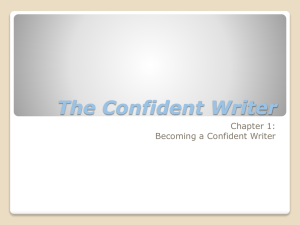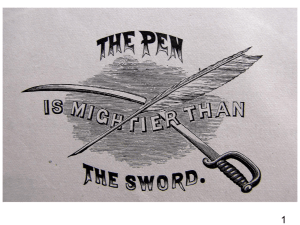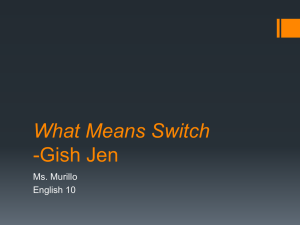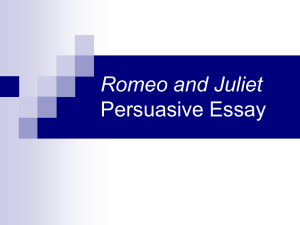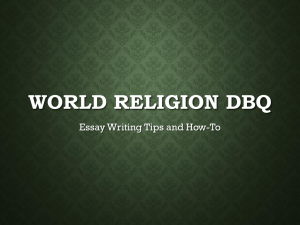A-C-E-I-T--Student - Lake
advertisement
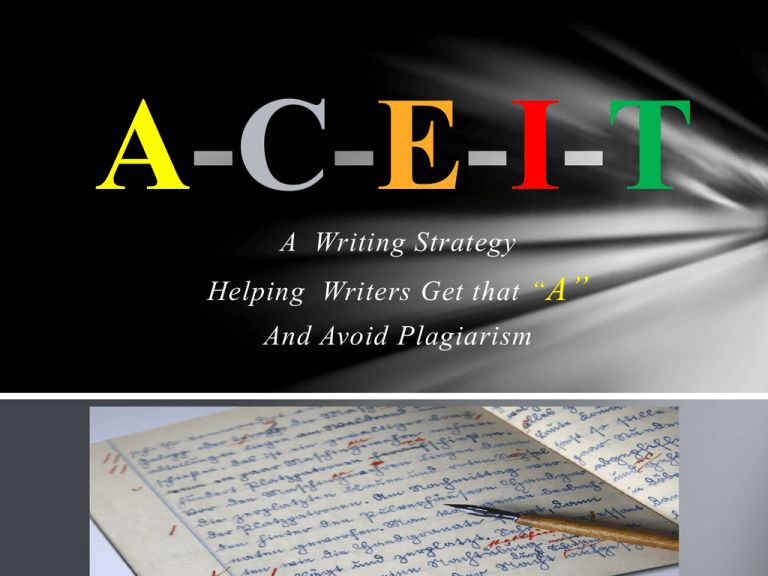
ACEIT A Writing Strategy Helping Writers Get that “ A” And Avoid Plagiarism What ACEIT stands for… A- Assertion C- Citation E- Explication I- Interpretation T- Transition/Termination Purpose All writers, whether in high school or in college, are often frustrated with the lower grades they receive for their academic essays. If you’re finding that this happens “more often, than not” for you, then the A-C-E-I-T is the writing strategy you need to consider. ESSAY’S STRUCTURE: The Functional Paragraphs Functional Paragraphs have important jobs to do. *The Introduction—grabs reader’s attention --includes background information, historical context, defined terms, thesis. --may include rhetorical question, related quotation, illustrative anecdote, shocking or provoking opening. *The Conclusion—takes reader back to thesis --restates main point; shows broader significance of the argument; ends with recommendation; takes reader back to the thesis. ASSERTION A is for ASSERTION. Every essay needs to make a point, a statement to prove. Remember the thesis? (It may appear anywhere in your essay, but it usually comes in the beginning.) What IS a Thesis? A well written essay needs to have a controlling thought, a clear and focused main idea. This clearly focused main idea is the THESIS and is always expressed in a complete sentence. What does the Thesis do? A Thesis…. *narrows the writer’s subject; *claims something specific and important about the subject; *conveys the writer’s purpose: often explanatory or argumentative; *previews the arrangement of ideas; *is debatable and/or arguable. Do not confuse TOPIC with THESIS. Topic: (Essay to Persuade) A “Greener” America Thesis: Complete recycling participation is essential if America is to become a “greener,” more responsible nation environmentally. Topic: (Essay of Literary Analysis) Illusion vs. Reality in Arthur Miller’s Death of a Salesman Thesis: Living lives of illusion and existing in worlds filled with false hopes creates the struggle of illusion vs. reality for the Loman family in Miller’s drama Death of a Salesman. CITATION C is for CITATION. To support a thesis, a writer needs to use credible and reliable sources to develop the essay. These sources are used judiciously and sparingly throughout the essay’s developmental paragraphs*. All citations need correct documentation, giving credit for their original publication. *Paragraphs that support and “develop” the thesis. Which form of Documentation? BEFORE the writer decides upon any research format, he/she should check with the instructor and/or institution policy. _______________________________________________________________ Otherwise these formats are generally accepted: MLA (Modern Language Association) for classes in literature, language, art, music, humanities APA (American Psychological Association) for classes in the sciences, both laboratory and social CHICAGO (a form of the old “Turabian” style) for classes in history requiring document based research Reliable vs. Non-reliable Sources When evaluating sources for possible citation use, ask the following: *Does it devote attention to the topic (relevance)? *Is the source up-to-date? *Where does the source come from? *Is the author an expert in the field? *Is there author bias? *Is the source fair, reasonable, and well-written? *Is the author’s claim well supported? *Are the sources used judiciously, or as needed, throughout the essay? Adding “Muscle” to the Body of the Essay The major flaw of most student academic writing lies in OVER citation with UNDER development of details in the paragraphs of the body. This creates only a “skeletal” piece of writing. Plagiarism: Pure and Simple • Taking and using reference material without correctly citing it. • Illegally summarizing and/or paraphrasing without correctly citing the material. • Inserting ideas, any ideas or thoughts, not originating in the mind of the writer. • Erroneously assuming new material is already established and known by the reader. • Using vocabulary and sentence structure not of the writer’s original “voice” or “style.” Consequences of Plagiarism Any or all of the following: *Zero on the assignment. *Notification to Administration: Department Chair, Dean of Academics, Principal *Written report in student’s permanent file. *Potential failure for the semester. *Dismissal from class and/or college. EXPLICATION E is for EXPLICATION. After any citation, the writer needs to “translate” what the quote, summarized information, etc. actually says. This establishes the writer’s credibility for the reader. (“What this passage—quote, research, data, etc.—says is….”) INTERPRETATION I is for INTERPRETATION. Once the writer has effectively “translated” or explicated the cited information, it is essential that it be brought back to the essay’s THESIS. In essence, the writer is relating what the citation means by bringing its importance and relevance back to the essay’s thesis. This provides further “muscle” to the developmental paragraphs of the essay’s body. Examples of EXPLICATION From a student’s literary analysis of Arthur Miller’s Death of a Salesman. According to one source, “Willy tried desperately to deny that his sons were failures, and that he was failing as a salesman” (Shockley 80). CITATION: Shockley clearly suggests that Willy is determined to avoid the truth regarding not only the failures of his sons, but his own failures as well. (What this says is……) EXPLICATION: Examples of INTERPRETATION From a student’s literary analysis of Arthur Miller’s Death of a Salesman. EXPLICATION: Shockley clearly suggests that Willy is determined to avoid the truth regarding not only the failures of his sons, but his own failures as well. (“What this says is…”) INTERPRETATION: These failures to recognize the truth, the realities of his life, continue to cause Willy, along with others in the Loman family, to delve deeper into the world of illusion. (“What this means is…”) This will continue to add “muscle” to your developmental paragraphs. TRANSITION T is for TRANSITION If the writer has successfully developed his/her first major detail supporting the essay’s thesis, the next step is to gracefully TRANSITION to the next developmental detail supporting the thesis. Effective use of TRANSITION, both within the paragraphs and between the paragraphs, enhances the essay’s coherence, or flow of ideas. Without TRANSITION, the essay becomes choppy and randomly developed. Methods of TRANSITION Transition can be achieved in many ways: 1) using transitional expressions and phrases; 2) repeating keywords or key ideas; 3) using pronouns with clear antecedents; 4) using enumeration (1, 2, or first, second, etc.); 5) summarizing a previous paragraph; 6) asking a question; and 7) using a transitional paragraph. Methods of TRANSITION Certain words and phrases are inherently transitional: FUNCTION TERMS Result therefore, as a result, consequently, thus, hence Example for example, for instance, specifically, as an illustration Comparison similarly, likewise, in comparison Contrast but, yet, still, however, nevertheless, on the other hand, by contrast Time now, presently, later, meanwhile, since then, after that, before that time Sequence first, second, third, initially, then, next, finally This list is only a representative one; there are many more. Check your style manual. TERMINATION T is (also) for TERMINATION Once the developmental sections of the essay are complete, it then becomes necessary to provide an effective ending to it. This functional paragraph, or section, is the essay’s conclusion or TERMINATION. This part of the essay, functional in nature, is just as important as the essay’s introduction, in that it provides closure for the reader. This section is the essay’s “Terminator.” Strategies for TERMINATION Some strategies for writing effective conclusions include: *recommending a course of action; *summarizing the essay; *echoing major ideas from the introduction; *restating thesis and reflecting on its implications; *striking a note of hope or despair; *giving a symbolic or powerful fact or other related detail; *suggesting an especially compelling related example; *creating an image that represents the subject; and *using a meaningful, but related, quotation. Strategies for TERMINATION Strategies to avoid when writing an effective conclusion: *Repeating the introduction. The conclusion should capture what the paragraphs of the body have added to the introduction. *Using a “sweeping” generalization. The conclusion should not bring in more than what the evidence contained can support. *Offering an apology. If there is doubt cast within the essay, the reader will not have the necessary confidence in what has been presented. References Aaron, Jane E. The Little, Brown Compact Handbook with Exercises. 7th ed. New York: Longman, 2010. Print. Alred, Gerald J. et. al. The Business Writer’s Handbook. 11 ed. New York: Bedford/St. Martin’s, 2006. Crowley, Alan. Instruction on using the ACEIT. Alvirne High School. 1996-2001. Lecture. Miller, Leonard M. Using the ACEIT in Academic Writing. Lake Sumter Community College. 2010-. Lecture.



